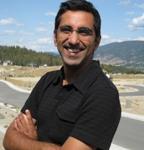Hussein Keshani

Associate professor
Steering committee
Telephone: 250-807-9770
Email: hussein.keshani@ubc.ca
After initially studying architecture, I chose to pursue art history at the University of Victoria, BC, where I completed my MA and PhD. Art History sometimes gets a bad rap as being fluffy, but I’m really drawn to the field’s interdisciplinary nature, since studying visual cultures generally requires knowledge of artmaking practices, history, religion, cultural practices, languages, literature and many other areas. In Victoria, we were encouraged to study many different regions and periods of the world before specializing. My focus became South Asia and the Islamic World. Why study South Asia and the Islamic World? The beautifully detailed miniature paintings, the stunning monuments, the intriguing sculptures and the graceful calligraphy that you find are definitely seductive. Current trends in graphic and gallery art and architecture are also fascinating. But, I also think it’s a great way to learn about people and traditions that are too often misunderstood in our contemporary world. My research interests have led me all around North India where I studied 14th C Sufi shrines and 18th C ritual centres called imambaras. I’m now working on a book project that examines how Muslim notions of gender shape images and space in 18th and 19th C North India. I’m also working on the use of computing technologies to advance visual cultural research. I have been fortunate to have held postdoctoral fellowships with the Aga Khan Program for Islamic Architecture at Harvard/MIT, the Introduction to Humanities program at Stanford and with SSHRC at the University of Victoria’s History in Art department. The areas I have taught include introductory courses in European and Islamic art history, advanced courses on literature and gender in Islamic art and architecture, South Asian art and architecture, Islamic history, as well as theory and methods of visual cultural interpretation and analysis. I think it’s important to encourage students to examine their own assumptions about art and culture and I place importance on helping students to read critically, to form arguments, and to use evidence and theories to develop their arguments. I’m really pleased to be part of a program and faculty that is committed to interdisciplinarity and perhaps most importantly encouraging students to think critically and learn more about the world’s diverse cultures.